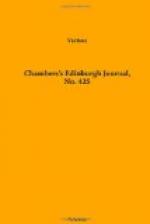The story of this fatal retreat has been often told. The result was communicated in the following manner to the British troops shut up in Jelalabad: ’At last, on the 13th of January, when the garrison were busy on the works, toiling with axe and shovel, with their arms piled and their accoutrements laid out close at hand, a sentry on the ramparts, looking out towards the Cabool road, saw a solitary white-faced horseman struggling on towards the fort. The word was passed; the tidings spread. Presently the ramparts were lined with officers, looking out, with throbbing hearts, through unsteady telescopes, or with straining eyes tracing the road. Slowly and painfully, as though horse and rider both were in an extremity of mortal weakness, the solitary mounted man came reeling, tottering on. They saw that he was an Englishman. On a wretched, weary pony, clinging, as one sick or wounded, to its neck, he sat or rather leant forward; and there were those who, as they watched his progress, thought that he could never reach, unaided, the walls of Jelalabad. A shudder ran through the garrison. That solitary horseman looked like the messenger of death. Few doubted that he was the bearer of intelligence that would fill their souls with horror and dismay. Their worst forebodings seemed confirmed. There was the one man who was to tell the story of the massacre of a great army. A party of cavalry were sent out to succour him. They brought him in wounded, exhausted, half-dead. The messenger was Dr Brydon, and he now reported his belief that he was the sole survivor of an army of some 16,000 men!’[3] From this wholesale butchery, which we are not disposed to detail, the women and children, the general, and the husbands of the ladies, were rescued by Akbar Khan. They were held for a time by the son of Dost Mahomed in a sort of captivity; where some of them had leisure to write narratives of their adventures, while others, with an inconsistence common and entertaining in melodramatic pieces, amused themselves with fun and frolic!
And what became of Shah Soojah? ’Rising early on the morning, he arrayed himself in royal apparel, and, accompanied by a small party of Hindostanees, proceeded under a salute, in a chair of state, towards his camp, which had been pitched at Seeah-Sungh. But Soojah-ool-dowlah, the son of the Newab, had gone out before him, and placed in ambush a party of Jezailchees. As the shah and his followers were making their way towards the regal tent, the marksmen fired upon them. The volley took murderous effect. Several of the bearers and of the escort were struck down, and the king himself killed on the spot. A ball had entered his brain. Soojah-ool-dowlah then rode up; and as he contemplated his bloody work, the body of the unhappy king, vain and pompous as he was to the very last, was stripped of all the jewels about it—the jewelled dagger, the jewelled girdle, the jewelled head-dress—and it was then cast into a ditch.’




